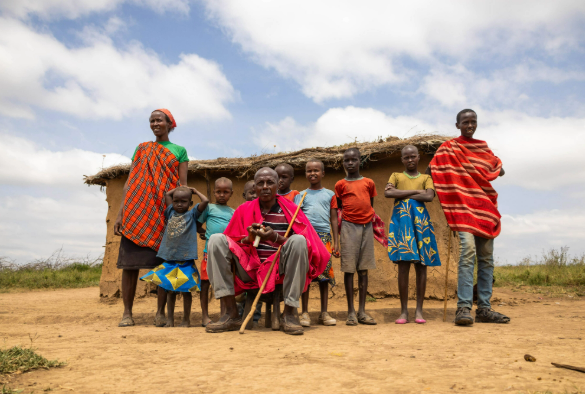Professor Dan Pope directs the UK National Institute for Health and Care Research (NIHR) CLEAN-Air(Africa) Global Health Research Unit. Here he sends a postcard from Narok County in Kenya:
In Kenya 26,000 people die each year from smoke produced by burning wood, charcoal and kerosene for household energy. Our NIHR CLEAN-Air(Africa) Global Health Research Unit is conducting programmes of research and health systems strengthening to help tackle household air pollution, the largest environmental risk factor for disease burden.
This summer I travelled to Narok County in Kenya, home to 1.1 million, largely Masai, residents where 22% of the population live in food poverty and 3 in 4 households live in multidimensional poverty. I travelled with our community health engagement lead, Nancy Chebichii, University of Liverpool partners from Kenya Medical Research Institute (KEMRI) and the Office of the First Lady of the Republic of Kenya’s ‘Joyful Women Organisation’ (JOWO). JOWO sponsors 16,500 women’s ‘table banks’ to save small amounts of money for purchasing food and key goods known as a merry-go-round system.
We were there to launch a new CLEAN-Air(Africa) initiative providing evidence-based information on household air pollution to JOWO table banks delivered to communities by their inspiring community health workers – known as Table Banking Led Education for Prevention of Household Air Pollution (TABLE-HAP).
We had already had much success with the first phase of the TABLE-HAP launch to train1,500 table banks in Usain Gishu County, West Kenya. This first phase had led to adoption of clean cooking for 40% of the trained women and health messaging reaching 100,000 members of the community. We wanted to understand how TABLE-HAP would be received (and improved) by this hard to reach, nomadic community with distinct challenges in accessing clean household energy.
When we arrived, we were warmly greeted by a Narok Community Health Workers (CHW) who introduced us to one of their families. Here we saw Mama cooking for her children in their household.
The main fuel used is wood and biomass gathered from around their compound. Burning these fuels gives off toxic smoke where health damaging respirable particles are more than 100 times greater than World Health Organisation (WHO) safe levels for health. Our eyes were streaming and throats burning as water was boiled for tea. The family were unmoved by the smoke, habituated to its presence after a lifetime of reliance on polluting fuels for the basic necessity of cooking. I recalled a presentation by the late Professor Kirk Smith, one of the first public health experts to raise the global health burden of household air pollution to the international community – “cooking with wood in an open fire is equivalent to burning 400 cigarettes in an hour.”
We were extremely grateful to the wonderful family for their hospitality, but troubled to experience, first hand, the “killer in the kitchen” from the simple act of cooking with biomass.
We moved to the makeshift community centre to observe the Narok CHWs deliver TABLE-HAP training to 30 chairwomen from the counties JOWO table banks. The CHWs effortlessly delivered the TABLE-HAP training (my translator highlighting key messages from the training) “think of the dirt and soot on your walls, and now think about your lungs.”
The atmosphere during the training was both exhilarating and humbling – every woman had a story when the CHWs prompted them during the training. Examples including the tragic passing of a resident due to carbon monoxide poisoning from use of charcoal for heating, and many accounts of respiratory illness (chronic cough and pneumonia) for the women themselves and their children as a result of exposure to “Moshi” (smoke). There were also many excited discussions about solutions – putting in a chimney, increasing ventilation, drying wood before using it and, importantly, using money from the table bank to switch to clean cooking with a Meko (a 6kg LPG cylinder with a burner on the top that is popular in Kenya). We were delighted by these discussions – they were exactly the same conversations other women had had during training in Uasin Gishu where we had observed such an amazing transition to clean cooking.
Everyone we had encountered during this visit left an impression on me. From the wonderful Narok community to the energised and professional JOWO table bankers and especially, the fantastic Narok CHWs who were clearly both part of the community and trusted advocates for health promotion.
Through our policy of Community Engagement and Involvement, we will continue to engage with our research communities and CLEAN-Air(Africa) will return in the 2025. I will be back with representatives from the Kenyan Ministries of Health and Energy to convert a Masai School in Narok to clean and green energy through an off grid solar system for cooking provided by our new partner AGREATE. I am really looking forward to providing our new postcard with an update from Narok.
